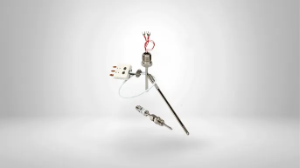RTD vs Thermocouple: How to Choose the Best Temperature Sensor for Manufacturing and Food Processing
When you work in manufacturing or food production, temperature isn’t just a number, it’s the difference between safe, efficient operations and costly mistakes. From keeping food at the right temperature during processing to monitoring heat in industrial ovens or tanks, the sensor you choose plays a critical role.
Two of the most common options you’ll come across are RTDs (Resistance Temperature Detectors) and thermocouples. At first glance, they both measure temperature. But the way they work, and where they work best, can be very different.
How Each Sensor Works
RTDs (Resistance Temperature Detectors)
RTDs utilize a straightforward principle: the electrical resistance of metal changes in response to changes in temperature. Platinum is the most commonly used metal, which makes RTDs reliable and stable.
Thermocouples
Thermocouples are built from two different metals joined together at one end. When that junction gets hot or cold, it creates a small voltage. That voltage is what tells you the temperature.
Key Differences between RTDs and Thermocouples
Accuracy and Stability
When it comes to accuracy, RTDs generally come out ahead. They are the better choice when food safety regulations or strict quality standards are in play because they provide consistent, precise measurements over time. Thermocouples are less accurate and can drift as they age, but their durability often makes up for this in certain environments.
Temperature Range
The temperature range is a major dividing line between the two sensors. Thermocouples can withstand extremely high temperatures, up to approximately 1800 °C in some cases, which makes them essential in furnaces, kilns, and other high-temperature applications. RTDs typically reach a maximum temperature of around 850 °C. That’s sufficient for most food and general manufacturing operations, but not for industries like steel or glass, where heat exceeds those limits.
Durability and Maintenance
Durability also plays a role. Thermocouples stand up well in harsh conditions, including vibration and mechanical stress. RTDs, while accurate, are more delicate and better suited to stable environments. When it comes to maintenance, RTDs hold calibration longer, requiring fewer adjustments. Thermocouples are tougher in the field but degrade faster, meaning they need more frequent recalibration.
Cost Differences
Cost often influences the choice between RTDs and thermocouples. Thermocouples are less expensive upfront, which makes them appealing when extreme accuracy is not required. RTDs have a higher price tag, but their long-term stability and precision can save money by reducing waste, preventing product recalls, and improving overall process efficiency.
Choosing the Right Sensor for Your Application
In food processing, where maintaining pasteurization temperatures or monitoring storage tanks demands strict accuracy, RTDs are usually the better fit. In contrast, manufacturing plants that deal with furnaces or other high-heat equipment will benefit from the ruggedness and wide temperature range of thermocouples. The best choice depends on your environment, your process requirements, and the balance between cost and precision.
Centro’s Expertise in Temperature Sensors
At Centro, we know that no two facilities operate the same way. The decision between an RTD and a thermocouple depends on your specific process, the environment, and your goals for efficiency and safety. Our team works with manufacturers and processors to evaluate these factors and guide you toward the best solution.
If you’re exploring temperature sensors for your facility, contact our product experts at Centro today. We can help you determine whether an RTD or a thermocouple is the right fit and connect you with solutions that keep your operation reliable, efficient, and compliant.

